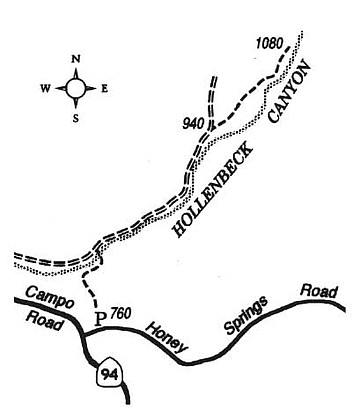 Facebook
Facebook
 X
X
 Instagram
Instagram
 TikTok
TikTok
 Youtube
Youtube
The acquisition of approximately 3500 acres of Daley Ranch property near Jamul last year by California's Wildlife Conservation Board led to the establishment of the Hollenbeck Canyon Wildlife Area, now being managed by the California Department of Fish and Game. About half of the property remains closed to the public, while the remaining half is open to hiking, horseback riding, and seasonal bird hunting (late October through January). Pets on leash are welcome, but vehicles -- including mountain bikes -- are not.
Despite the scant rainfall of the past year and the dry-as-dust condition of the landscape out there right now, the area still invites a brief visit -- even this summer. Just arrive during the cool early-morning or early-evening hours. Posted hours are one-half hour before sunrise to one-half hour after sunset.

Take Highway 94 southeast from Jamul to Honey Springs Road, and find the large trailhead parking area 0.1 mile east along the latter road. A one-third-mile passage on the trail ahead, through a parched and barren meadow, hardly prepares you for the idyllic scene soon to come. You pass a yellow-topped post marking the route of the historic (and currently discontinuous) California Riding and Hiking Trail, and descend gently into shallow Hollenbeck Canyon, which at this point is lined by an agreeable collection of massive coast live oaks and leafy California sycamores. One of the first oaks in sight is a grizzled, misshapen survivor of past fires soaring some 50 feet into the sky. The trail soon curves left to cross the now-dry canyon bottom and joins a dirt road. Stay right -- and remember this juncture on your way back, when you will be tracing this same route backward.
Onward you go alongside a thin green strip of willow, mule-fat, and other riparian vegetation, with a stray Engelmann oak or two joining the coast live oaks and sycamores. The side walls of the canyon, clothed in a desiccated veneer of dormant sage-scrub vegetation, gradually close in tighter. From this vantage, no sign of civilization save the road you walk upon is apparent. The wind whispers in fluttering leaves.
At 1.3 miles from the start, a side path goes left about 50 yards to the foundation remains of a cabin. Soon after (on the main route), a side trail diverges to the right from the wider path that climbs upward along a broad ridge. Both alternatives run into the boundary of public land not far ahead. The more interesting of the two is the path to the right. It threads the eroded west wall of the narrowing gorge ahead. At 2.0 miles, a yellow sign identifies the property line of the wildlife area. At that spot, there's a vertiginous view into the "narrows" of Hollenbeck Canyon, where floodwaters tumbling down from upstream Lyons Valley have cut a nearly vertical trench in the bedrock. Off in the distance, eastward, floats the 3738-foot summit of Lyons Peak.

The acquisition of approximately 3500 acres of Daley Ranch property near Jamul last year by California's Wildlife Conservation Board led to the establishment of the Hollenbeck Canyon Wildlife Area, now being managed by the California Department of Fish and Game. About half of the property remains closed to the public, while the remaining half is open to hiking, horseback riding, and seasonal bird hunting (late October through January). Pets on leash are welcome, but vehicles -- including mountain bikes -- are not.
Despite the scant rainfall of the past year and the dry-as-dust condition of the landscape out there right now, the area still invites a brief visit -- even this summer. Just arrive during the cool early-morning or early-evening hours. Posted hours are one-half hour before sunrise to one-half hour after sunset.

Take Highway 94 southeast from Jamul to Honey Springs Road, and find the large trailhead parking area 0.1 mile east along the latter road. A one-third-mile passage on the trail ahead, through a parched and barren meadow, hardly prepares you for the idyllic scene soon to come. You pass a yellow-topped post marking the route of the historic (and currently discontinuous) California Riding and Hiking Trail, and descend gently into shallow Hollenbeck Canyon, which at this point is lined by an agreeable collection of massive coast live oaks and leafy California sycamores. One of the first oaks in sight is a grizzled, misshapen survivor of past fires soaring some 50 feet into the sky. The trail soon curves left to cross the now-dry canyon bottom and joins a dirt road. Stay right -- and remember this juncture on your way back, when you will be tracing this same route backward.
Onward you go alongside a thin green strip of willow, mule-fat, and other riparian vegetation, with a stray Engelmann oak or two joining the coast live oaks and sycamores. The side walls of the canyon, clothed in a desiccated veneer of dormant sage-scrub vegetation, gradually close in tighter. From this vantage, no sign of civilization save the road you walk upon is apparent. The wind whispers in fluttering leaves.
At 1.3 miles from the start, a side path goes left about 50 yards to the foundation remains of a cabin. Soon after (on the main route), a side trail diverges to the right from the wider path that climbs upward along a broad ridge. Both alternatives run into the boundary of public land not far ahead. The more interesting of the two is the path to the right. It threads the eroded west wall of the narrowing gorge ahead. At 2.0 miles, a yellow sign identifies the property line of the wildlife area. At that spot, there's a vertiginous view into the "narrows" of Hollenbeck Canyon, where floodwaters tumbling down from upstream Lyons Valley have cut a nearly vertical trench in the bedrock. Off in the distance, eastward, floats the 3738-foot summit of Lyons Peak.
Comments